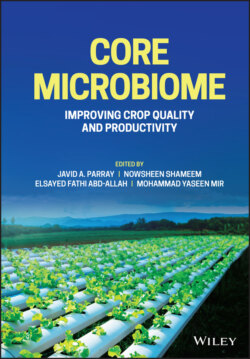Читать книгу Core Microbiome - Группа авторов - Страница 10
1.3 Current Trends on Bioactive Metabolites from Endophytic Microbiota of Medicinal Plants
ОглавлениеA significant development in the understanding of plant-associated microbiota has been prompted by massive DNA sequencing technology in the past decade. Such close connection of microorganisms with plants has a broad contribution to plant nutrient absorption, growth, stress tolerance, and health status, and secondary metabolite production [14]. Metal hyper-accumulating plants are known to shelter a co-evolved microbiota [15,16], and an essential role has been recognized in microbial-assisted phytoremediation [17]. Medicinal plants are well-known to shelter endophytes that are potentially concerned with the biosynthesis of phytoconstituents and can synthesize bioactive compounds.
The composition of biologically active components of medicinal plants differs broadly depending on their soil type, plant species, and their association with microorganisms [18,19]. These plant-linked microbial communities and their physiological functions are also strongly influenced by bioactive secondary metabolites synthesized by medicinal plants [20–22]. Moreover, for specific character and activities, including growth, nutrient acquirement, induced systemic resistance, and tolerance to abiotic stress factors, plants depend on their microbiome [23–27]. Although many medicinal plants are well-studied with relation to their microbiome, phytochemical constituents, and pharmacological properties, the physiological interactions between host and microorganisms remain inadequately understood [28]. The plant-linked microbiome consists of different microbial communities existing within the endosphere, shoots, and roots [27,29]. The rhizosphere of many plants is known to be a potential source for selecting good microorganisms that may affect plant health and is well-studied [21,30,31]. Hence, a valuable understanding of the microbial ecology of plant-associated bacteria may provide by considering the response of microbial communities to adaptation within the physiochemical atmosphere of the rhizosphere. The abundance of antagonistic bacteria within the rhizosphere of medicinal plants like sweet false chamomile (Matricaria chamomilla), Solanum distichum, and common marigold (Calendula officinalis) was observed [32]. The root-linked bacteria of Ajuga bracteosa displayed a broad range of plant growth-promoting activities by producing siderophores (iron-chelating compounds) and indole ethanoic acid and reveal antioxidant activity [33]. The vast and considerable collection of endophytic fungi from neem may represent a distinct source of the useful bioactive antimicrobial and insecticidal compounds [table 1.1] associated with Azadirachta indica such as the azadirachtins and related tetranortriterpenoids [50]. Recently, endophytic microbes have been on the verge of increased investigation due to their close interaction with the host [34]; it is assumed that the phytochemical constituents of plants are related, however, directly or indirectly, to endophytic microorganisms and their associations with host plants [20,35].
Table 1.1 Some Endophytic fungi obtained from different parts of neem tree. [54]
| Genus (former name) of Endophytic fungi | Parts of neem tree | References |
|---|---|---|
| Trichoderma | Root, seed, leaf, bark, flower | [51,53] |
| Verticillium | Root | [51,53] |
| Humicola | Flower | [51,53] |
| Chloridium | Root | [51] |
| Nigrospora | Root, seed, leaf, bark | [50,51,53] |
| Scytalidium, Penicillium | Root | [51] |
| Aspergillus | Root, seed, leaf, bark, flower | [52] |
| Alternaria, Drechslera | Flower | [50,51] |
| Phoma | Leaf | [53] |
| Periconia | Bark | [50,53] |
| Stenella | Bark | [50] |
| Cercinella | Root | [51] |
